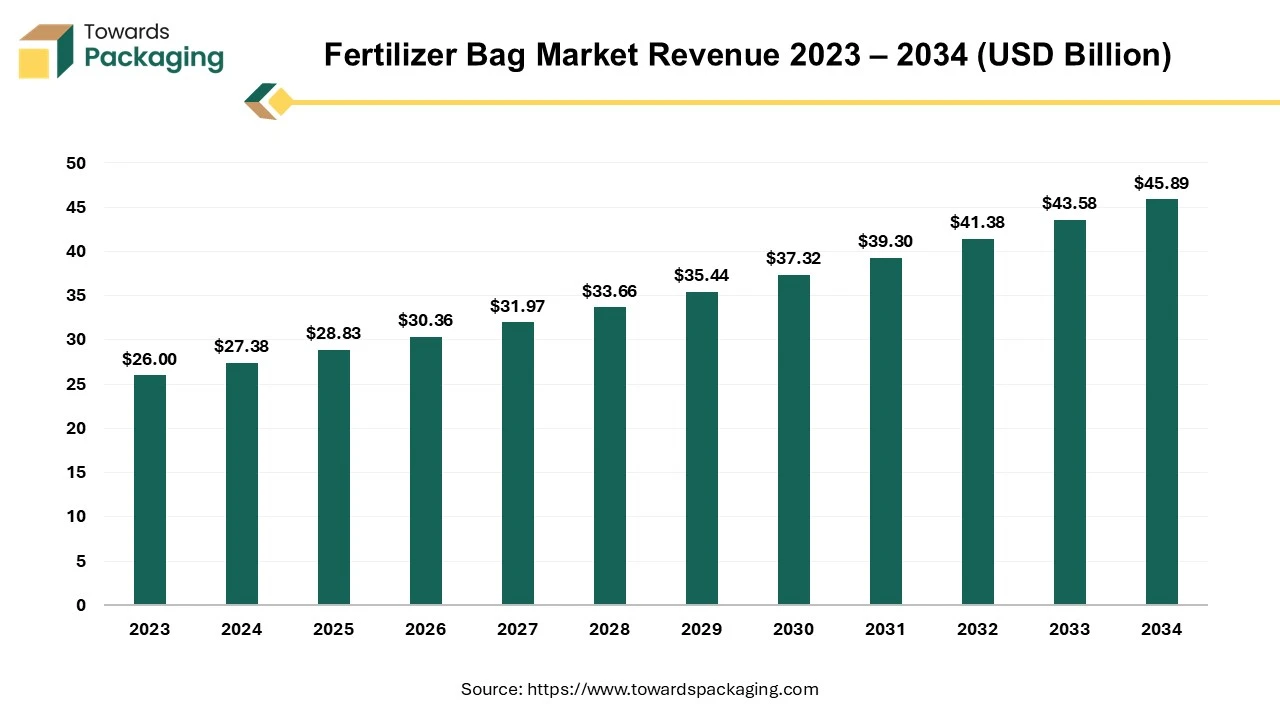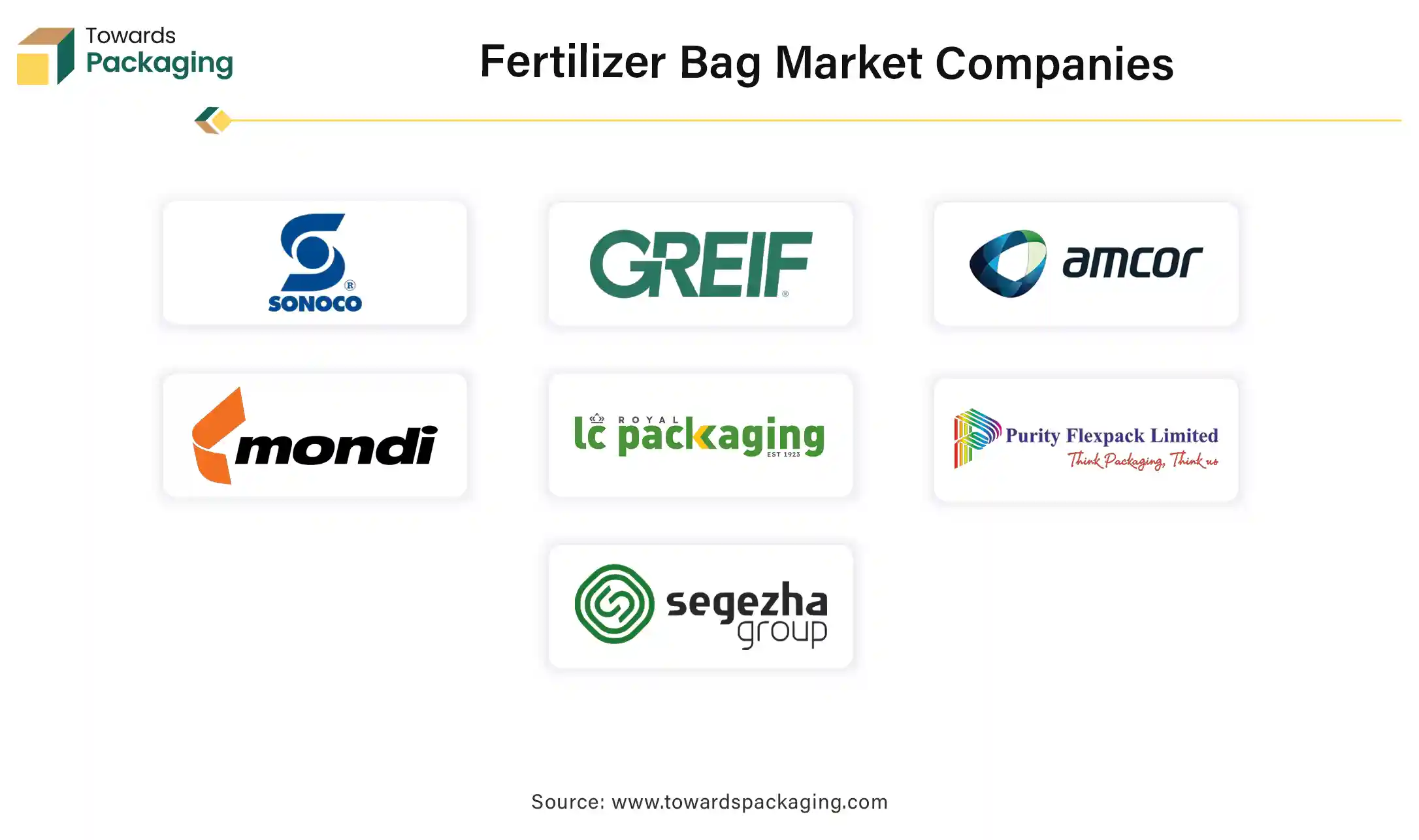December 2025
The fertilizer bag market is projected to reach USD 45.89 billion by 2034, growing from USD 28.83 billion in 2025 at a CAGR of 5.30%. The market growth is fueled by population rise, expanding food demand, and government support for agriculture. This comprehensive report covers market segmentation by type (LDPE, PP, burlap, others) and application (agriculture, gardens, sports fields, household). It offers detailed regional analysis across North America, Europe, Asia Pacific, Latin America, and the Middle East & Africa, where Asia Pacific leads while North America shows the fastest growth. The study also includes an in-depth competitive landscape, profiling companies like Amcor, Mondi, Sonoco, Greif, and Berry Global, along with value chain, trade statistics, and supplier–manufacturer data for a holistic market perspective.

Global fertilizer bag market growing due to population growth this increase causes food consumption to rise and will continue to drive the need for increased fertilizer usage and the government also supports agricultural products.
The global fertilizer bag market is growing rapidly due to the importance of fertilizers in the agricultural process. If customers want to get involved in agriculture production, they will need a lot of fertilizers and since most of the fertilizers are in powder form, they need to start using the bag accordingly. Fertilizer bags can be in different types and qualities. Environmental concerns, fertilizer type, consumer preferences, and cost are important factors to consider. Fertilizer bags are a great way to keep garden tools fresh and ready to use.
These are waterproof, durable bags that keep fertilizer safe and handy when needed. They are durable and designed to protect fertilizer from leakage and contamination, making them the best choice for gardeners and farmers. Fertilizer bags are made of plastic, burlap, cloth, or other materials. There are many options for plastic, such as PE bags, PP woven bags, and composite film bags. Burlap bags have long been used to package fertilizers. Modern-day, bags made of PE materials are on the rise as they have many advantages in protecting the contents. Also, some important functions like valve ports, and exhaust valves can be added to PE bags.
The global fertilizer bag market is driven by many factors including the increasing need for packaging solutions that provide safety and efficiency. In agriculture, there is an increasing need to package solid products that can withstand environmental issues, especially moisture, while reducing spillage. Furthermore, the shift to sustainable practices has led to the exploration of various materials, costs, and environmental impacts. In addition to the need for good packaging, the need for expanded transport capacity and multiple storage seasons supports the important role of packaging in maintaining fertilizer integrity and expanding the overall market.
Traditional plastic packaging has always been harmful to the environment. Awareness of the problem is increasing the demand for sustainable packaging, which includes products designed to break down faster and reduce the ecological footprint. Compostable packaging is gaining traction as a good alternative because these materials break down in composting environments, turning them into usable products. Innovations such as EcoPure additives are increasing the compostability of packaging materials, making them attractive for the market. Bags manufactured with EcoPure additives decompose faster in compost facilities, providing a practical solution for waste management and creating a significant opportunity for the development of the global fertilizer bag market.
The transportation of bulk fertilizers using poorly designed bags poses significant challenges, especially due to the hygroscopic nature of bulk fertilizers, which easily absorb water from the surface. This hygroscopicity is challenging for commercial storage and transportation and must be tightly packed to ensure product integrity. Comprehensive fertilizer products involve heavy loading and unloading operations, so good packaging must be used to maintain quality throughout transportation and storage. Improper packaging can lead to product spoilage and logistics inefficiencies, which can ultimately limit the growth of the global fertilizer bags market.
Asia Pacific held the largest share of the global fertilizer bag market and the region is observed to sustain the dominance during the forecast period due to the fertilizer subsidies in South Asia, which will lead to more synthetic nitrogen, such as urea, being used in the field. Although this has been successful in increasing yields. The growth in overall volume in Asia Pacific is increasing due to high demand for fast-moving customers. The growth of the global flexible agriculture packaging industry is driving the fertilizer packaging market.
For Instance,
North America is observed to grow at the fastest rate in the global fertilizer bag market with regional insights as the number of organic farms increases, and sales of certified products are on the rise U.S. farms and ranches sell approximately $7.6 billion in certified organic products. Improvements in agricultural packaging have had an impact in driving innovation in agriculture. United States Department of Agriculture (USDA) Secretary Tom Vilsack has announced a major new initiative to improve domestic fertilizer production. The program works with U.S. employers to create jobs in rural areas and support local businesses.
By Type
By type, the low-density polyethylene (LDPE) segment dominated the global fertilizer bag market as it is a flexible material with unique flow properties that make it a particular bag for storing fertilizer. Whereas polypropylene (PP) segment is the fastest-growing in the global fertilizer bag market as it is tough, breathable, cost-effective, and ideal for packaging agricultural products.
By Application
In terms of application, the agriculture segment dominated the global fertilizer bag market as they are specifically designed to protect fertilizers in their internal seal, thus ensuring that no bacteria or moisture comes along with the fertilizer. Although the garden segment is the fastest-growing in the global fertilizer bag market, every gardener appreciates the benefits of grow bags, an easy solution for gardeners with limited space.

The CEO of CF Industries highlighted the company’s strategy to innovate in both fertilizer production and packaging. During a recent earnings call, he discussed the launch of new, more efficient fertilizer bags that improve usability and reduce environmental impact, signaling a strong push for market expansion.
By Type
By Application
By Geography
December 2025
December 2025
November 2025
November 2025